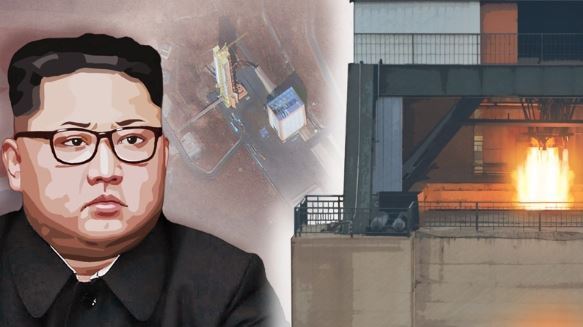N. Korea likely tested liquid-fuel engine for rockets: US expert
By YonhapPublished : Dec. 11, 2019 - 11:50
WASHINGTON -- North Korea's "very important test" over the weekend likely involved an existing liquid-fuel engine for rockets, not a solid-fuel one, a US expert said Tuesday.
Pyongyang has not revealed details of the test other than to say that it took place at the Dongchang-ri satellite launch site on Saturday and that the results "will have an important effect on changing the strategic position" of the country.
Speculation has mounted that North Korea tested an engine for a new long-range missile to increase pressure on the United States to make concessions in their stalled nuclear negotiations before the end of the year.

Michael Elleman, senior fellow for missile defense at the International Institute for Strategic Studies, wrote in an analysis on the website 38 North that no solid-fuel engine is known to have been tested at the launch site, also known as Sohae.
"The Vertical Engine Test Stand at Sohae ... appears to be designed only for liquid-fuel engines, which are much lighter than their solid-fuel counterparts," he wrote, citing photographs of previous tests of the RD-250 engine for the Hwasong-12 intermediate-range ballistic missile and the Hwasong-14 and 15 intercontinental ballistic missiles.
Elleman explained that the liquid propellant for liquid-fuel engines is typically stored in large tanks near the test stand, requiring the test stand to withstand only the thrust generated by the engine during testing.
Solid motors, on the other hand, hold the propellant in the casing, thus requiring the test stand to hold in place the mass of the entire motor.
Elleman also said that because first-stage, solid motors for an ICBM typically weigh between 20,000 and 30,000 kg, and those of IRBMs weigh between 15,000 and 20,000 kg, engineers are compelled to test them horizontally, not vertically.
While it is possible that North Korea has reinforced its vertical engine test stand at Sohae to accommodate large solid motors, "this seems unlikely given the expense and the less-than-compelling need to test solid motors in a vertical position," he said.
Elleman suggested the possibility that North Korea tested a variation of the RD-250 to be used on its IRBMs and ICBMs.
"If North Korea has begun serial production (of engines), it would very likely want to test at least some of the manufactured engines to ensure performance and reliability standards are maintained, particularly if the number of long-range missiles Pyongyang plans to deploy is less than a few dozen," he said.
Elleman also left open the possibility that a new engine design was fired.
"One leading possibility might be a cluster of four or six RD-250 combustion chambers for a notional satellite launch vehicle capable of lifting a heavy satellite to medium or high-altitude orbits," he wrote. "Such possibilities are speculative, of course, but they would be consistent with some of North Korea's previously stated ambitions to orbit large satellites." (Yonhap)








![[KH Explains] Hyundai's full hybrid edge to pay off amid slow transition to pure EVs](http://res.heraldm.com/phpwas/restmb_idxmake.php?idx=644&simg=/content/image/2024/04/18/20240418050645_0.jpg&u=20240419100350)







![[From the Scene] Monks, Buddhists hail return of remains of Buddhas](http://res.heraldm.com/phpwas/restmb_idxmake.php?idx=652&simg=/content/image/2024/04/19/20240419050617_0.jpg&u=20240419175937)

![[KH Explains] Hyundai's full hybrid edge to pay off amid slow transition to pure EVs](http://res.heraldm.com/phpwas/restmb_idxmake.php?idx=652&simg=/content/image/2024/04/18/20240418050645_0.jpg&u=20240419100350)

![[Today’s K-pop] Illit drops debut single remix](http://res.heraldm.com/phpwas/restmb_idxmake.php?idx=642&simg=/content/image/2024/04/19/20240419050612_0.jpg&u=)